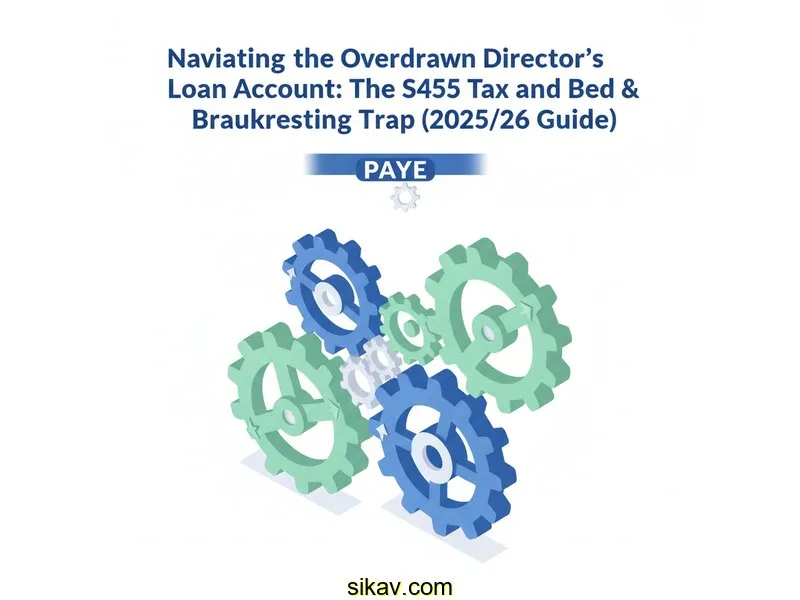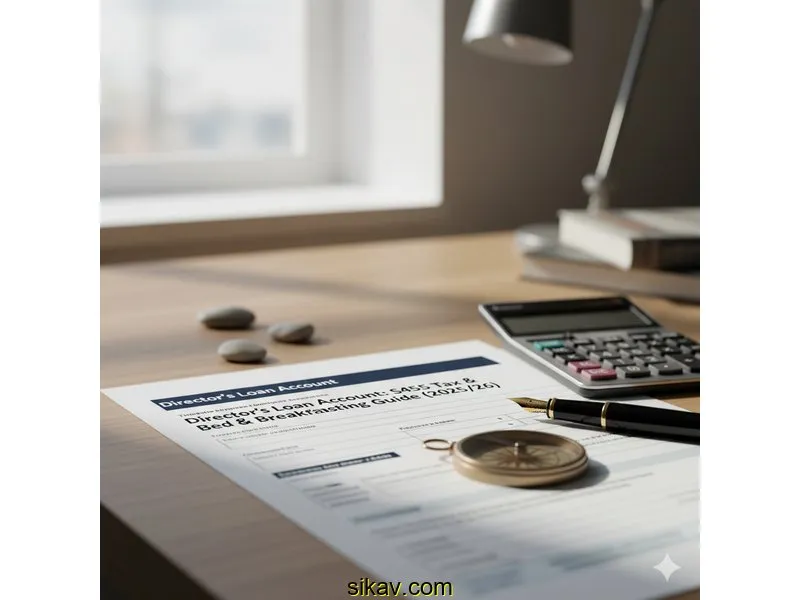
Picture this: You’re the sole director of a successful limited company in Leeds. You’ve taken money out of the business throughout the year to cover personal expenses, planning to clear the balance when the year-end accounts are finalised. That running tab is your **Director’s Loan Account (DLA)**, and it's overdrawn by £45,000.
You know you need to repay it, but you’re staring down the barrel of the nine-month and one-day Corporation Tax deadline. If you miss it, your company faces a brutal 33.75% tax charge on the outstanding amount—HMRC's way of punishing you for using company money as an interest-free personal loan. This punitive tax, known as **Section 455 (S455) Tax**, is one of the most common and expensive traps for UK limited company directors. It’s not just the charge itself; it's the subtle timing and repayment rules that catch out even experienced business owners.
Key Takeaways
- Core Rule 1: Repayment Deadline: An overdrawn DLA balance must be repaid within **9 months and 1 day** of the company’s year-end to avoid the 33.75% S455 tax charge.
- Core Rule 2: Bed & Breakfasting: HMRC targets artificial repayments. If you repay the loan just before the deadline and withdraw a similar amount shortly after, the repayment may be ignored, and S455 tax will apply.
- Key Data Point: Penalty Risk: HMRC generated over **£2 billion** in Corporation Tax receipts in 2024/25 alone from small to medium-sized enterprises (HMRC Statistics, 2025), a portion of which includes non-compliance penalties and S455 charges, highlighting the risk.
- When to Act: Quarterly Review: Directors should monitor the DLA balance at least **quarterly** and ensure any repayment strategies are documented and legally sound.
- Disclaimer: This article provides informational guidance based on HMRC rules for the 2025/26 tax year. It is not financial or legal advice. DLA rules are complex and penalties for errors are significant—always consult a qualified accountant for your specific situation.
The Director's Loan Account: Why HMRC Cares
Let's explore the fundamental concept. A Director's Loan Account acts as a ledger recording all transactions between the director and the company that are **not** salary, dividends, or reimbursed expenses. If the company owes you money, the DLA is 'in credit' (an asset for you). If you owe the company money (an overdrawn DLA), it’s treated as a personal loan and becomes a company asset.
HMRC imposes S455 Tax because, in their view, an overdrawn DLA allows the director to extract profits without paying the correct income tax and National Insurance that a salary or dividend would attract. They want to discourage this profit extraction method. To do this, they apply the S455 charge, a temporary tax on the company, which is currently set at **33.75%**—a rate that intentionally makes overdrawn loans prohibitively expensive.
Think of the S455 tax as a **non-refundable deposit on a debt**. The company can claim the S455 tax back, but only *after* the director repays the loan. If you repay the £45,000 loan, your company can reclaim the £15,187.50 S455 tax (£45,000 x 33.75%). However, this reclaim can only happen 9 months and 1 day after the end of the accounting period in which the loan was repaid. The cost to your business is the loss of that cash for at least 18-24 months.
This matters because the financial burden of the S455 tax often outweighs the convenience of a short-term loan. An analysis of HMRC Corporation Tax compliance data revealed that a substantial number of small and medium-sized enterprises (SMEs) face compliance checks related to DLA errors, with repayment timing being the most common issue (Accountancy Age Industry Report, 2024).
Scenario-Based Breakdown: Avoiding the S455 Charge
The key to compliance rests on the exact timing of the DLA repayment relative to the company’s year-end and the subsequent filing deadline. To make sense of this, let's break down the three most critical scenarios UK company directors face. The table below shows exactly how different repayment methods and timings impact the S455 tax liability.
| Scenario | DLA Repayment Action | S455 Tax Consequence | Immediate Tax Effect | What You Must Do |
|---|---|---|---|---|
| 1. Full, Timely Repayment | Repaid in full **before** the 9-month/1-day deadline. | **0%** S455 Tax is charged. | None—The company’s asset (the loan) converts back to cash. | Ensure the funds leave your personal account and clear into the company bank account on or before the deadline. |
| 2. Late Repayment (Accidental) | Repaid in full **after** the 9-month/1-day deadline (e.g., 10 months after year-end). | **33.75%** S455 Tax is charged on the outstanding balance. | Company pays S455 tax. It can be reclaimed 9 months after repayment date. | File the CT600 correctly, pay the S455 tax, then make the repayment. Claim the tax back later (the cash-flow hit is unavoidable). |
| 3. Loan Cleared by Dividend | A dividend is declared and offset against the overdrawn DLA balance. | **0%** S455 Tax is charged, *provided* the company had sufficient reserves. | Director incurs personal dividend tax liability. The DLA is cleared without cash movement. | Ensure all dividend paperwork is legally compliant and company reserves exist. This is the most tax-efficient way to clear a DLA. |
| 4. The "Bed & Breakfasting" Trap | Repaid just before the deadline, then a near-identical amount is re-drawn shortly after. | **33.75%** S455 Tax is charged on the original loan balance (HMRC disregards the 'repayment'). | Director faces penalties for misreporting; company pays S455 tax. | Avoid artificial, short-term repayments. Maintain the repaid balance for at least 30 days to demonstrate genuine intention (see deep dive). |
As you can see, the critical factor is the repayment date. However, the last scenario—the “Bed & Breakfasting” trap—is where HMRC has cracked down hardest. This is the attempt to circumvent the rules by making a temporary repayment, and it requires a deeper explanation.
Deep Dive: The S455 Bed & Breakfasting Rule

The **Bed & Breakfasting** rule, formally introduced in 2013, prevents directors from avoiding S455 tax through temporary, artificial repayments. This is an anti-avoidance measure designed to ensure the DLA is genuinely cleared, not just temporarily masked for the tax deadline.
Think of it like washing your car before a valuation. If you clean it up, get the high price, and then immediately cover it in mud again, the valuation company might suspect foul play. HMRC applies a similar suspicion to DLA repayments.
HMRC focuses on two key thresholds for repayments:
The £5,000 Threshold
If the DLA repayment is **less than £5,000**, the bed and breakfasting rule is not typically triggered, even if a new loan is taken out shortly after. This is the 'safe harbour' for minor adjustments.
The 30-Day Rule and Intent Test
The S455 rule is triggered if two conditions are met: 1) the loan is repaid on or before the 9-month/1-day deadline, AND 2) the director takes out a new loan of **£5,000 or more** within 30 days of the repayment. If this happens, the repayment is treated as if it never occurred for S455 tax purposes, and the company is immediately liable for the 33.75% charge on the entire balance. HMRC’s guidance specifically states that if repayments are quickly followed by new loans, the initial repayment is disregarded, “unless the repayment was made for genuine commercial reasons” (HMRC Company Taxation Manual, CTM61635, 2025). The burden of proof is on you to demonstrate genuine intent.
To implement a safe and compliant strategy, the director might: 1) Clear the DLA by declaring a legal dividend (Scenario 3), 2) Make a genuine, full repayment and ensure no significant withdrawal occurs for at least 30 days, or 3) If the loan will not be repaid in time, budget for the S455 payment and treat it as a temporary cost, planning the recovery claim for the following year.
Edge Cases and Advanced Director's Loan Traps
The DLA world is full of complexities beyond the basic S455 risk. One subtle area is the **Beneficial Loan** charge. If the DLA is interest-free, the director receives a benefit in kind (BIK). While DLA interest rates are often set at or above the official rate (which was 2.25% in 2024/25, then increasing to 2.50% in 2025/26 - HMRC rates, 2025) to avoid this BIK, it is another compliance detail to track.
Another pitfall is the **writing off** of a Director’s Loan. While it clears the DLA, it creates two separate tax bills: a tax liability for the director (treated as an unearned dividend and taxed at their marginal dividend rate) and a National Insurance liability for the company. This is rarely the most tax-efficient method to clear an overdrawn balance.
Common Questions About Director's Loan Accounts
Based on questions I've seen across UK freelancer forums and director communities, here are the three most common points of confusion related to overdrawn DLAs and the S455 rules.
I'm taking a low salary/high dividend. Can I use the DLA to manage my cash flow throughout the year?
Yes, this is precisely what a DLA is for, but with strict caveats. It allows you to draw cash before declaring a formal dividend or paying salary. However, the loan must be cleared by the 9-month/1-day deadline, most efficiently by a dividend declaration. If you fail to declare a dividend large enough to clear the balance, you are back in the S455 trap. The strategy is acceptable, provided the end-of-year accounts show the DLA is legally cleared.
Does the S455 tax apply if the loan is interest-free and I pay the Benefit in Kind (BIK) tax?
Yes, the S455 tax and the BIK charge are completely separate. The **BIK charge** (via your self-assessment) covers the benefit of receiving an interest-free loan. The **S455 tax** (via the company's CT600 return) is a temporary penalty on the company for failing to repay the loan on time. Paying one does not exempt you from the other. To avoid the BIK, the DLA should charge you interest at the HMRC official rate.
How does HMRC actually catch the 'Bed & Breakfasting' repayment?
HMRC uses data analytics to cross-reference the timing of repayments reported on the CT600 with the new loans taken out soon after. Their systems flag large repayments made close to the 9-month/1-day deadline that are followed by significant withdrawals within the next 30 days. Furthermore, your accountant is legally required to report if the overdrawn loan was repaid by a dividend or if a repayment followed by a new advance was a genuine commercial transaction (HMRC Form CT600A, 2025). The tax form itself is designed to catch this practice.
Conclusion: Your Next Steps
Understanding the Director's Loan Account is not just about bookkeeping; it’s about managing cash flow and avoiding a potentially disastrous, non-refundable tax bill. The main takeaway is that you have 9 months and 1 day to clear the balance, and the most tax-efficient method is almost always to clear the DLA via a legally declared dividend. The critical element to remember is the **Bed & Breakfasting** rule: do not make a large, last-minute repayment with the intention of re-borrowing the funds immediately after the deadline. This practice is specifically targeted by HMRC and will lead to the S455 charge, penalties, and interest.
If you are a UK limited company director, start by confirming your company’s year-end and calculating the 9-month/1-day deadline for DLA repayment. Ensure you have clear, documented board minutes for any dividend used to clear the loan. For most directors, moving away from relying on the DLA as a long-term funding source and using a structured salary/dividend mix is a cleaner and lower-risk strategy. However, given the complexity of the S455 tax (33.75%) and the penalties associated with the Bed & Breakfasting rules, for a specific and compliant strategy tailored to your company's reserves and profitability, always consult a qualified accountant who specialises in small to medium-sized limited companies.

